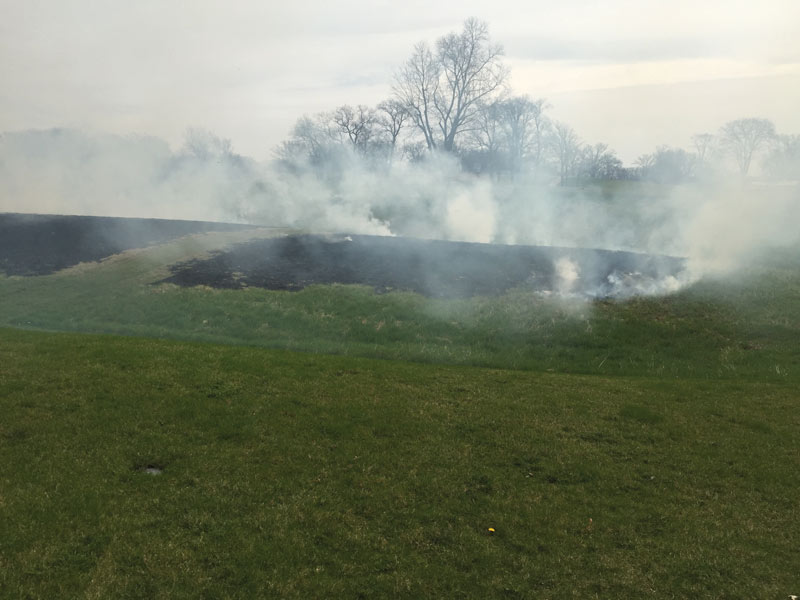
A prescribed burn underway at TPC Deere Run in Silvis, Ill. Photo courtesy of Alex Stuedemann
If you search online for the terms “golf course,” “fire” and “burn,” almost all of the hundreds of results will be stories of clubhouse fires or cart barns catching flame. Very few articles will point you to the positive attributes of using prescribed burning to manage golf course vegetation.
Fire is a natural part of most North American ecosystems, and it provides a number of benefits to the plants and animals (including humans) that inhabit those ecosystems. Working as a wildlife biologist for the past 30 years, I’ve witnessed the destructive effects of some wildfires, primarily in the western United States, but I’ve also seen the tremendously positive response native vegetation and many animal species have experienced as a result of wildfires or prescribed burns. When used properly, prescribed fire can:
-
Recycle nutrients back to the soil
- Promote the growth of trees, shrubs, wildflowers and other native plants
- Minimize the spread of diseases and insect pests
- Provide an increase in food for pollinators and other beneficial insects, songbirds and many other animals
- Reduce the buildup of hazardous fuels, protecting communities from extreme fires and allowing for more effective fire suppression if wildfires do occur
- Remove or reduce some invasive or unwanted species, which threaten native ecosystems
Properly managed prescribed fires can rejuvenate a grassland, savanna, woodland or forest into a lush, healthy biological community. Almost every golf course has areas (many of them out-of-play) that could benefit from the use of correctly applied prescribed fire to maintain healthy native vegetation. Some of the advantages particularly pertinent to golf courses include reduced erosion, reduced mowing, boosted beneficial insect numbers, potential reduction of chemical use on the course, improved water quality on and off the course, increased wildlife viewing opportunities, and the added beauty of wildflowers and flowering shrubs and trees.
Assemble a team
Knowing when and how to best employ fire as a tool requires specialized training many superintendents and golf course maintenance staffs may not have. It is indeed a science, and a bit of an art as well. For this reason, I highly recommend teaming up with a trained professional in the use of prescribed fire. Local fire departments, county extension offices, state departments of natural resources, federal land management agencies (U.S. Forest Service, U.S. Fish and Wildlife Service, Bureau of Land Management, Natural Resource Conservation Service), and nonprofit organizations (such as the Audubon Society, The Nature Conservancy, Xerces Society, Native Plant Society and local master naturalist chapters) are all possible partners and valuable sources of information, advice and labor.
With the help of a local volunteer fire department, Alex Stuedemann, superintendent at TPC Deere Run in Silvis, Ill., and an 18-year GCSAA member, has been using prescribed burning for the past two years, and says he’s been pleased with the results. Isaac Breuer, superintendent at Gustin Golf Course in Columbia, Mo., has been harnessing the power of fire for almost 20 years with assistance from the Missouri Department of Conservation. The 17-year GCSAA member says he’s been encouraged by the positive response not only from flora and fauna, but also from golfers and others in the community who have taken note of the favorable effects.
From Massachusetts to Florida to Nevada, a number of other superintendents have used prescribed fire as an effective tool for maintaining and enhancing landscapes. You don’t have to start from ground zero — talk to a superintendent near you to get an idea of how the practice might best work in your area.
The process
For any potential prescribed burn, the first step is to contact your local fire department to learn about permits, training requirements, and restrictions regarding zoning, time of year, time of day, and local conditions.
Next, identify your objectives for using fire on your course. What specifically do you hope to accomplish? Removing grass? Reducing weeds? After that, have your trained professional write a prescribed fire burn plan describing the conditions (wind, relative humidity, temperature, etc.) that will allow for the burn to be implemented successfully. Finally, before you burn, inform golfers, club members and your neighbors about your plan to increase awareness of and support for it.
Post-burn, monitor the project’s results. Did the implementation go as planned? Did the results of the burn (the next day, the next month, after one year, after three years) meet your expectations?
The strategic use of fire, the size of the area to be burned, the timing of the burn, the frequency of returning to the same area will be unique to each golf course, but some common, basic rules can guide your efforts: Don’t burn it all (leave some similar areas unburned), don’t burn it every year, don’t burn at the same time of year every year, and don’t burn it all black (allow for green or brown spots — known as “skips” — within a burned area). As my colleague Paul Charland at the U.S. Fish and Wildlife Service says, “Pyrodiversity equals biodiversity.”
Wedge Watkins is a wildlife biologist and Midwest region pollinator coordinator with the U.S. Fish and Wildlife Service. He is based at Big Muddy National Fish and Wildlife Refuge in Missouri.